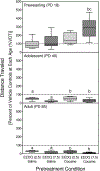Age-dependent effects of dopamine receptor inactivation on cocaine-induced behaviors in male rats: Evidence of dorsal striatal D2 receptor supersensitivity
- PMID: 31304635
- PMCID: PMC6801044
- DOI: 10.1002/jnr.24491
Age-dependent effects of dopamine receptor inactivation on cocaine-induced behaviors in male rats: Evidence of dorsal striatal D2 receptor supersensitivity
Abstract
N-ethoxycarbonyl-2-ethoxy-1,2-dihydroquinoline (EEDQ), which irreversibly inactivates dopamine (DA) receptors, causes pronounced age-dependent behavioral effects in rats. For example, EEDQ either augments or does not affect the DA agonist-induced locomotor activity of preweanling rats while attenuating the locomotion of adolescent and adult rats. The twofold purpose of this study was to determine whether EEDQ would: (a) potentiate or attenuate the cocaine-induced locomotor activity of preweanling, adolescent, and adult rats; and (b) alter the sensitivity of surviving D2 receptors. Rats were treated with vehicle or EEDQ (2.5 or 7.5 mg/kg) on postnatal day (PD) 17, PD 39, and PD 84. In the behavioral experiments, saline- or cocaine-induced locomotion was assessed 24 hr later. In the biochemical experiments, dorsal striatal samples were taken 24 hr after vehicle or EEDQ treatment and later assayed for NPA-stimulated GTPγS receptor binding, G protein-coupled receptor kinase 6 (GRK6), and β-arrestin-2 (ARRB2). GTPγS binding is a direct measure of ligand-induced G protein activation, while GRK6 and ARRB2 modulate the internalization and desensitization of D2 receptors. Results showed that EEDQ potentiated the locomotor activity of preweanling rats, while attenuating the locomotion of older rats. NPA-stimulated GTPγS binding was elevated in EEDQ-treated preweanling rats, relative to adults, indicating enhanced functional coupling between the G protein and receptor. EEDQ also reduced ARRB2 levels in all age groups, which is indicative of increased D2 receptor sensitivity. In sum, the present results support the hypothesis that D2 receptor supersensitivity is a critical factor mediating the locomotor potentiating effects of EEDQ in cocaine-treated preweanling rats.
Keywords: G protein-coupled receptor kinase 6 (GRK6); GTPγS receptor binding; N-ethoxycarbonyl-2-ethoxy-1,2-dihydroquinoline (EEDQ); ontogeny; β-arrestin-2 (ARRB2).
© 2019 Wiley Periodicals, Inc.
Conflict of interest statement
CONFLICT OF INTEREST STATEMENT
The authors have no conflicts of interest to report.
Figures







References
Publication types
MeSH terms
Substances
Grants and funding
LinkOut - more resources
Full Text Sources
Medical

